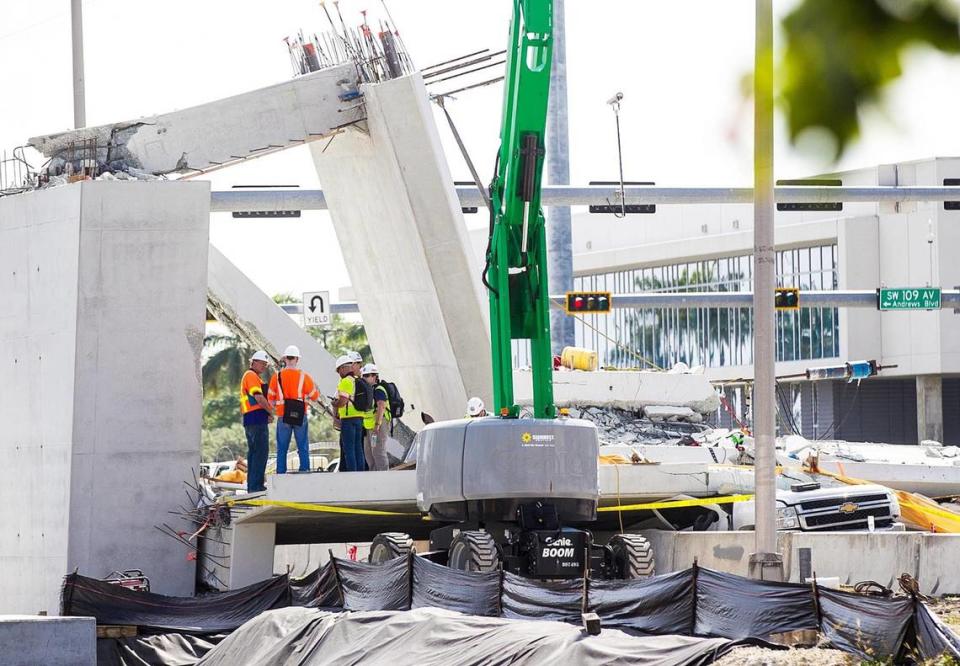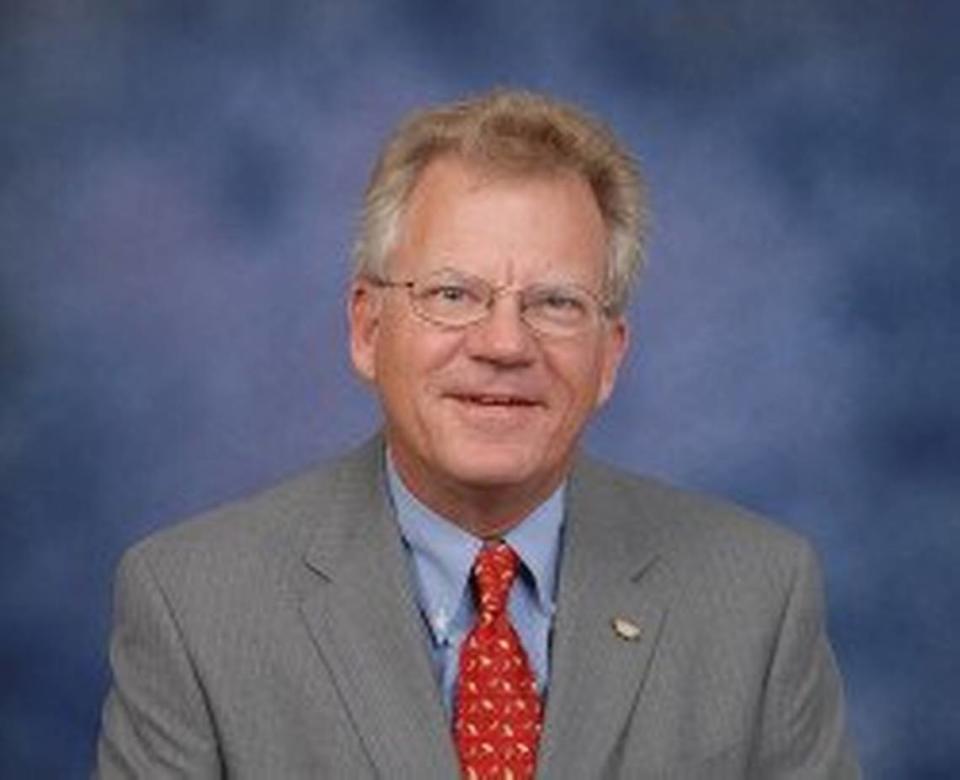Repercussions of failed FIU bridge in 2018 on key players and where they are now
On the morning of March 15, 2018, a dozen engineers and contractors involved in the design and construction of a pedestrian bridge for Florida International University’s main campus met in a trailer at the site to discuss what to do about deep cracks that had spread along one end of the unfinished concrete span.
Virtually everyone there, investigators would later conclude, made the wrong — and fatal — call.
The renowned engineer who came up with the bridge’s unorthodox, but dazzling design played down the significance of the cracks. Even while admitting he didn’t know the cause, W. Denney Pate insisted the bridge was safe and dismissed a suggestion from an inspecting engineer that it be shored up as a precaution, records show.
Pate — who investigators later determined had overlooked a critical error he’d made in the bridge’s design — then ordered what turned out to be an ill-considered attempt to close up the cracks. Shortly after the meeting ended, the repair work caused the 950-ton span to collapse, crushing several cars waiting at a red light below it on Southwest Eighth Street, killing six people and injuring 10 others.
READ MORE: Cautious new bridge design almost ready
READ MORE: Timeline of what’s occurred since bridge fell in 2018
The unusually expansive cracks should have been an alarming sign to the experienced builders in the trailer that the bridge was in severe structural distress, exhaustive and sharply critical federal investigations found.

But no one at the meeting — not Pate, not an FIU representative, not state transportation officials or contractors — raised the possibility of closing the street while the repair work was undertaken, according to the reports. That simple measure, federal and state investigators said, would have saved lives and limbs.
Five years later, the repercussions of the FIU bridge’s shocking failure are still being felt, though some appear to remain unresolved.
Federal highway officials laid out new requirements for design reviews and road closures when cracking is found on overhead structures. The Florida Department of Transportation took over control of the bridge project from FIU, and on Feb. 28 unveiled plans for a new footbridge that adopts a highly conservative approach to design and construction, including frequent road and lane closures at night on Southwest Eighth during overhead work.
Project contractors created a $103 million pool from insurance proceeds to compensate victims of the collapse, and numerous suits and counterclaims among consultants have been settled.
The engineers involved in the project have largely avoided formal professional sanctions. Records show that two FDOT engineers involved in oversight of the project, Robert Robertson and Tom Andres, acting as private individuals, filed complaints with the state board of engineers against at least three of the project engineers, including Pate.
Last year, Pate surrendered his Florida engineering license and said he’s retired for good after engineering board reviewers concluded he had been negligent. Yet, he has steadfastly continued to deny culpability. The board dismissed complaints against two other engineers on the project. The result of a fourth complaint can’t be determined because of confidentiality rules.
The construction and engineering firms involved, meanwhile, all appear to be in business and even thriving. The sole exception may be the company where Pate was lead design engineer, FIGG Bridge Group of Tallahassee, which was subsequently fired from two major bridge projects in Texas after the collapse and barred for 10 years from federally funded projects, its main source of income.

There’s only one further potential shoe to drop, however: A criminal investigation by the Miami-Dade State Attorney’s Office remains open, though no details have emerged and it’s unclear how active it is. A spokesman for State Attorney Katherine Fernandez Rundle called the office’s investigation “completely thorough” but declined to elaborate.
“After sitting down with the SAO attorneys involved with the intensely detailed examination of the collapse of the FIU bridge, I have been made acutely aware that this criminal investigation is still ongoing,” office spokesman Ed Griffith said in an emailed statement to the Miami Herald.
“The State Attorney understands that the anniversary of a tragedy such as the FIU bridge collapse is significant to victims, their families, and the public. However, the anniversary of a tragic event is not a factor in our office’s decision-making process on whether or not criminal charges should be filed. As you know, felonies that result in death have no statute of limitations. This important fact gives us the needed time to conduct a completely thorough investigation of this incredibly complex and complicated case. Since this matter is still the subject of an ongoing criminal investigation, it would not be appropriate for us to comment on it further. “
One critical factor leading to the tragedy, a trove of investigative documents released following the collapse conclude, was a complicated and unwieldy contracting structure with no clear lines of authority when it came time to address the cracks. Everyone on the team yielded to Pate’s judgment, and no one seemed ready or able to overrule him or challenge his view.
Under the scheme approved by FDOT, the agency delegated oversight and contracting for the project to FIU under the rules of the state’s Local Agency Program.
To build and design the bridge, FIU hired politically plugged-in Miami contractor Munilla Construction Management, or MCM (now known as Magnum Construction Management). MCM in turn hired renowned Tallahassee-based FIGG Bridge Group to design the bridge. To review its design, FIGG contracted with Louis Berger, a national engineering firm based in New Jersey.
FDOT hired yet another consultant to help coordinate the project, but said that under the LAP rules the agency adopted a mostly hands-off approach. Records released after the collapse, though, suggest the agency had a more active role than it acknowledged, with FDOT engineers often looking closely over the shoulder of project contractors.
Here is what’s happened with some of those key players in the failed project:
▪ W. Denney Pate. Following an investigation by the Florida Board of Professional Engineers, Pate, the bridge’s lead designer and lead design engineer for FIGG, was allowed to give up his state license on condition that he pledge not to seek reinstatement. Pate has not admitted culpability in the deadly bridge collapse, blaming instead a construction error by MCM and its subcontractors — a contention that federal and state investigators explicitly rejected.
Records indicate Pate may have licenses in other states, but where or whether they’re active could not be determined.

▪ FIGG Bridge Group: Federal highway officials barred the designers of the failed FIU bridge from any federally funded projects until 2029. Because most bridge projects have some federal financing, that could effectively end FIGG’s main business. The firm contested the suspension, but the outcome could not be determined. An engineer familiar with FIGG says the firm is not getting any new major projects, though it may be working in minor roles reviewing plans and performing construction inspections.
Since the collapse, FIGG was fired by the Texas Department of Transportation from major bridge projects in Corpus Christi and Houston after issues with Pate’s designs for the spans emerged. Construction on FIGG-designed Houston Ship Channel Bridge was halted after a review uncovered 21 “significant concerns.” Portions of the bridge structure had to be demolished, setting back the project two years and adding nearly $300 million to its cost.
A FIGG spokesman listed on the firm’s website, Bill Pettus, did not return messages seeking comment.
▪ Dwight Dempsey, a 16-year FIGG engineer who worked under Pate as field coordinator on the FIU bridge, was also the subject of complaints to the engineering board that claimed he was negligent in failing to recognize the gravity of the cracking and responding to it. But board reviewers concluded there was “no evidence” that he violated any engineering norms or rules. Their report said Dempsey had no apparent involvement in design or in interpreting data about the bridge, both of which were Pate’s responsibility.
Since 2019, Dempsey has worked as bridge practice group leader in the Tallahassee office of Kimley-Horn, a major engineering and design consulting firm.
▪ MCM, the general contractor, sued FIGG and went through a Chapter 11 bankruptcy reorganization after the collapse. As part of the bankruptcy, MCM — renamed Magnum Construction Management — set aside $42 million from its insurance coverage to compensate victims. Subsequently, MCM secured approval from Miami-Dade commissioners to extend a longstanding contract for work at Miami International Airport. MCM remains on that airport job and has several other county construction contracts.
▪ Louis Berger International, which conducted a review of Pate’s design plans that federal investigators said was inadequate, was acquired in 2018 following the FIU catastrophe by WSP, a Canadian conglomerate, and continues to operate under its own name. The NTSB faulted the firm for agreeing to a curtailed review in its contract with FIGG in order to save the bridge designers money. Louis Berger assigned a single engineer to the task who missed Pate’s design error because of the contract’s limited scope.
▪ Ayman Shama, the engineer who conducted the design review for Louis Berger, was also the subject of a complaint to the Florida Board of Professional Engineers. The agency said it could not discuss the case, suggesting the case was dismissed at an early stage or is still pending.
▪ Bolton Perez and Associates, the Miami engineering firm that acted as construction inspector on the bridge project, was faulted by federal investigators for insufficiently raising alarm over the cracks or exercising independent judgment to challenge Pate’s conclusions. Bolton Perez was acquired in 2021 by Colliers Engineering and Design, a national firm based in New Jersey, and now operates under that corporate name.
▪ Jose Morales, the Bolton Perez engineer assigned the FIU bridge inspection job, was also the subject of a complaint to the Florida engineering board. The complaint alleged Morales failed to question Pate’s conclusions and should have sought a second opinion from “seasoned” structural engineers at Bolton Perez.
But board reviewers cleared Morales, noting he had diligently fulfilled his job duties by photographing and documenting the cracks and sending reports to FIGG and MCM, requesting an independent analysis and suggesting the bridge be shored up as a precaution.
Morales was atop the bridge deck observing the repair job when it came apart and collapsed in a heap. He fractured his hip and jaw in the fall.
Editors’ note: An earlier version of this story stated that FIU contributed to the $103 million insurance victim’s compensation pool . FIU did not participate in the fund because it had no legal liability in the collapse.

